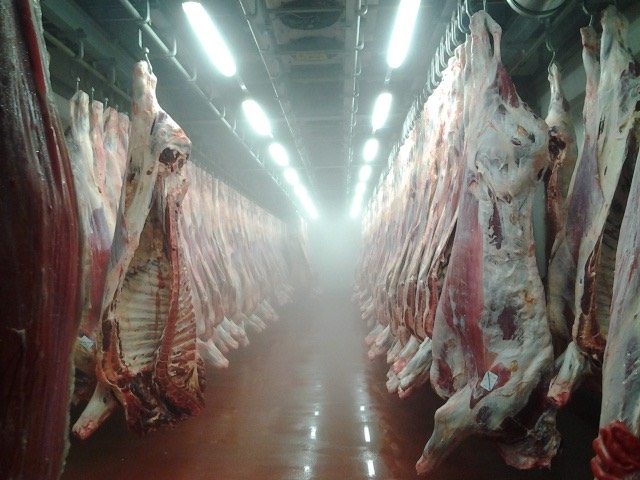The food production industry is enormous. Just taking a carrot from seed to your dinner table requires hundreds of processes, people and moving parts. One of those is humidity control, which is a vital component at several stages of food production; preservation and presentation, in particular. The ability to control humidity and temperature also plays a part in efforts to prevent contamination risks in food storage and food processing areas.
From meat to cheese, vegetables to fruit, they couldn’t happen without humidity control. The journey through food production, from start to finish with humidity solutions is outlined below.
In days gone by, crop growing was a fairly low-tech process. Over the years and as the technology improved and the demand grew, new techniques were developed to produce more crops more efficiently. Hydroponics technology was born in this context and it continues to develop even today!
Hydroponics is now a familiar way of generating high yields of crops from small indoor areas, allowing farmers to strictly control the growing cycle through lighting, temperature and humidity control. The process makes harvesting much simpler.
By controlling the climate of the crops so carefully and providing the right balance of nutrients, farmers can create perfect growing conditions all year round.
Humidity Solutions has been a pioneer in the hydroponics industry. Headquartered in Surrey, just outside London, in the UK, the company has supplied numerous industrial cold-water high-pressure systems to replace the previous stand-alone, small capacity units that had been standard in the industry for years.
By controlling the climate of the crops so carefully and providing the right balance of nutrients, farmers can create perfect growing conditions all year round.
The advantages of using such a high-grade commercial system are readily apparent, particularly because they give farmers the ability to control multiple areas from a single control panel, reducing maintenance and simplifying installation.
Systems with a simple flexible hose and push fit connections can be up and running in no time. Zoning functions mean that farmers can set a different humidity level for each area of their facility, making the growth of multiple, disparate crops —like tomatoes, cucumbers and mushrooms— at once.
This kind of humidity-based system is also a leader in the new area of medical cannabis growing.
Abattoirs
Humidity control isn’t just essential in the crop growing industry. It’s also important for meat production, specifically in abattoirs to reduce financial losses and waste. It can lead to positive operation benefits if done well.

The main financial loss in an abattoir is meat losing weight as it is cooled from a body temperature of 37°C down to 12°C in a 12-hour period. It’s fairly typical for a carcass to lose up to 3% of its weight during this refrigeration process.
To combat this, very fine sprays (produced by high-pressure water systems) can be used to surround carcasses with high humidity air, around 95% relative humidity (RH).
This reduces the evaporation process and limits the amount of weight lost during refrigeration.
Because the higher humidity air contains more water, as the carcass cools the air around it becomes a source of moisture, not a drain of it, keeping moisture in the product.
On a side of beef, this can be as much as 3 kg. Given that meat products are sold by weight, 3 kg of moisture loss would represent a significant loss in value, and therefore in profit.
The calculation to work out the impact on humidity on abattoirs is pretty simple: reduction in weight loss (kg) x the value of the product (£/kg) = money saved.
Over the yearly cycle of an abattoir, this can be many hundreds of carcasses, and therefore thousands of kilograms of product and tens of thousands of your currency saved.
Humidity control systems are simple to install. Nozzles are set below the evaporators to ensure quick evaporation within the space and good humidity distribution. And because a single pump has very low energy consumptions (around 1.5 kW and has no need for compressed air supply), it can control several areas on a facility at once for a much lower price.
Post-Harvest
Once crops have been harvested and other products created and packaged, they need to be transported to stores with enough life left in them to survive on the shelves. Humidification (also known as fogging) promotes faster, more efficient cooling, using less energy in the process.
In post-harvest, ultrasonic humidity control solutions are preferred, mainly because they use a finer water droplet size than high or low-pressure systems.
By ‘fogging’ the environment, transporters can sustain the life of these foods through natural hydration.
Keeping produce hydrated through post-harvest is incredibly important. Once picked, plants, vegetables and fruits will quickly dry out, especially in refrigerated environments designed to keep it from spoiling. By ‘fogging’ the environment, transporters can sustain the life of these foods through natural hydration.
Moreover, ultra-pure water can be used so fog particles can reach into every corner and stop dehydration from occurring. This also allows the producers to maximise the pick weight and yield since the product won’t lose its weight (and flavour) through dehydration. Cooling produce without dehydrating it is a common problem, especially since the market uses refrigerated air-cooling systems. For example, herbs could easily be damaged by harsh cooling methods like blast chilling, with high levels of dehydration causing them to wilt or break.
There are generally two ways to get around this problem:
- Add a cover to all pallets during the cooling process to manage the airflow and minimise the damage.
- Use a ‘dry’ fogging system to maintain moisture levels in the product during cooling.
You can supply ‘dry’ fogging systems to any area where post-harvest crops are stored, such as cold stores blast chillers, CA stores and other suppliers of fruit, vegetables and plants. In some cases, both methods might be used to protect produce.
One of the ways to tell how much your crops are being dehydrated is to measure the defrost water from the refrigeration system. It’s often alarming just how much water is being removed from products, simply through blast chilling.
Shelf Life
The distance between field and farm can be a real challenge, and long distances together with hot weather can lead to the rapid deterioration of the harvested product, a particular problem for leafy salads and vegetables.
To overcome this, systems have been developed to mist the field trailer, which allows cooling to begin while the crop is still in the field. This covers the produce in a thin layer of moisture which will evaporate during transit, without drawing any moisture from the product itself.
When delivered into the cold store, most growers, packers and shippers of baby leaf, salad and brassicas would then use an adiabatic crop hydration system. This system is now often specified for new-builds, but can also be retrofitted into existing cold stores.
The system first humidifies the air in the cold room to about 95% RH and only then is it able to fill the room with a visible fog made up of superfine purified water. As the system fills the cold room with fog, the vapour pressure increases, and the fog is pushed into every corner of the space.
The vapour pressure within the plants is lower than the vapour pressure in the room, and the effect is truly amazing. Delicate baby leaf, salads and brassicas absorb these droplets of water through the stomata in their leaves, sustaining life in a genuine, natural and organically friendly way. For example, baby leaf crops like perpetual spinach would normally start to wilt after two days in cold storage, depending on the weather conditions during harvest.
With our system, growers can leave the product in the conditioning fog for 24 to 48 hours before delivery to the packaging house. The storage lets the product cool to the desired temperature and fully hydrates it. This process actually leads to a better condition than when the product was first harvested. It can be kept in better than ‘as-picked’ condition for a total of 11 days. Only then will it start to wilt, but no faster than usual.
Manufactured products

John Barker, Humidity Solutions MD
Other sectors within the food industry also need humidity control and are often not considered. Bakeries that provide bread, or facilities producing charcuterie also require strict humidity control of the conditions to be effective.
Chiltern Charcuterie is an artisan producer, with award-winning salamis and air-dried charcuterie; butchering, curing, smoking and airdrying all done with locally sourced meat.
The project used an electrode boiler, which is a compact steam humidifier for a 12 m³ sealed fermentation room. The unit relies on precise humidity controls to maintain the necessary conditions for quality and consistency.
The humidifier provides up to 3 kg/h of steam to maintain a precise 85% relative humidity and a temperature of 25 °C.
In a separate room designed for the drying process, a humidifier is working alongside a dehumidifier, which has been installed to ensure that the heavy moisture laden new product in the first stages of drying does not produce so much airborne moisture that it creates a mould problem.
The desiccant dehumidifier controls the space at 80% RH, while the temperature is dropped to 12 °C.
Chiltern Charcuterie owner, John Miller, approached Humidity Solutions as he appreciated the experience in designing tailored humidity control solutions. “Humidity Solutions took the time to fully understand our requirements and propose the best solution; delivering the equipment within a few days. We are very pleased with the system and the service we received," Miller told me.
Similar problems are experienced in industrial bread making; from baked loaves to pizzas, steam plays a huge part in the process.
Humidity control helps companies actually produce certain types of foods, from sausages and salami to bread and cheese, wine and even mushrooms. As our world changes, the climactic conditions our food is grown, produced and stored in has never been more important, and humidity control solutions are an essential step in reducing waste and managing demand in today's ever-increasing population.
N.B. This article is featured in the April 2019 issue of Cleanroom Technology.
The digital edition is available online.




